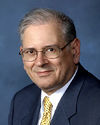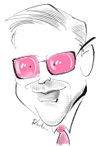Difference between revisions of "Robert Kahn"
| Line 20: | Line 20: | ||
In 1972, while working at [[DARPA]], he gave a presentation of the an ARPAnet network, connecting 40 different computers at the International Computer Communication Conference. This was the first time that much of the computing world, and the general population were introduced to the revolutionary network.<ref>[http://www.livinginternet.com/i/ii_kahn.htm LivingInternet.com]</ref> | In 1972, while working at [[DARPA]], he gave a presentation of the an ARPAnet network, connecting 40 different computers at the International Computer Communication Conference. This was the first time that much of the computing world, and the general population were introduced to the revolutionary network.<ref>[http://www.livinginternet.com/i/ii_kahn.htm LivingInternet.com]</ref> | ||
| + | |||
| + | Robert Kahn has rejected any type of "Father of the Internet" label, saying that today's Internet was created through a community effort.<ref>[http://www.theregister.co.uk/2007/01/18/kahn_net_neutrality_warning/ TheRegister.co.uk]</ref> | ||
===TCP/IP=== | ===TCP/IP=== | ||
While working at DARPA's [[IPTO|Information Processing Techniques Office]] Kahn took up work on a current project to establish a satellite packet network, and began a project on creating a ground-based radio packet network. Through his work in these projects he became aware of the need for an open-architecture network; wherein any network could communicate with any other individual hardware and software configuration. He created four goals for what was to the [[TCP| Transmission Control Protocol]]: | While working at DARPA's [[IPTO|Information Processing Techniques Office]] Kahn took up work on a current project to establish a satellite packet network, and began a project on creating a ground-based radio packet network. Through his work in these projects he became aware of the need for an open-architecture network; wherein any network could communicate with any other individual hardware and software configuration. He created four goals for what was to the [[TCP| Transmission Control Protocol]]: | ||
| Line 30: | Line 32: | ||
They designed powerful error and retransmission capabilities into TCP in order to provide more reliable communications; the design was thus formed around two protocols, TCP/IP. TCP is in charge of handling high level services, like the retransmission of lost packets, and [[IP]] addresses and transmits packets.<ref>[http://www.livinginternet.com/i/ii_kahn.htm LivingInternet.com]</ref> | They designed powerful error and retransmission capabilities into TCP in order to provide more reliable communications; the design was thus formed around two protocols, TCP/IP. TCP is in charge of handling high level services, like the retransmission of lost packets, and [[IP]] addresses and transmits packets.<ref>[http://www.livinginternet.com/i/ii_kahn.htm LivingInternet.com]</ref> | ||
| + | |||
==Contemporary Work== | ==Contemporary Work== | ||
In 2007, Robert strongly came out against [[Net Neutrality]] legislation; this type of legislation is largely opposed by prominent Internet engineers. Dr. kahn fears that discouraging experimentation on the fringes of the net's architecture will compromise the development of the still "very fragile" Internet. He calls the neutrality issue a bigger threat to the health of the Internet than possible fragmentation.<ref>[http://www.theregister.co.uk/2007/01/18/kahn_net_neutrality_warning/ TheRegister.co.uk]</ref> | In 2007, Robert strongly came out against [[Net Neutrality]] legislation; this type of legislation is largely opposed by prominent Internet engineers. Dr. kahn fears that discouraging experimentation on the fringes of the net's architecture will compromise the development of the still "very fragile" Internet. He calls the neutrality issue a bigger threat to the health of the Internet than possible fragmentation.<ref>[http://www.theregister.co.uk/2007/01/18/kahn_net_neutrality_warning/ TheRegister.co.uk]</ref> | ||
Revision as of 16:58, 30 May 2011
| Country: | USA |
Robert E. Kahn is the co-inventor of the TCP/IP system that established the architectural basis of the Internet. He worked with Vinton Cerf to write the famous paper, "A Protocol for Packet Network Interconnection".[1]
Dr. Kahn is the Founder, Chairman, CEO, and President of the Corporation for National Research Initiatives.[2]
The Beginning[edit | edit source]
Dr. Kahn first met Dr. Cerf at UCLA in 1969, after the ARPAnet nodes had been nationally distributed. At that time, he was working at an engineering firm in Cambridge, Mass., and travelled to UCLA to experiment with the new network. While at Bolt Beranek and Newman in Cambridge, Mr. Kahn helped build the Interface Message Processor.[3]
By the time they published their famous paper, in 1973, Vinton was a professor at Stanford, and Robert was working within the Defense Department's Advanced Research Projects Agency, the founders of the ARPAnet. They did not claim their protocols as intellectual property, and thus it was able to flourish as an open standard.[4]
In 1972, while working at DARPA, he gave a presentation of the an ARPAnet network, connecting 40 different computers at the International Computer Communication Conference. This was the first time that much of the computing world, and the general population were introduced to the revolutionary network.[5]
Robert Kahn has rejected any type of "Father of the Internet" label, saying that today's Internet was created through a community effort.[6]
TCP/IP[edit | edit source]
While working at DARPA's Information Processing Techniques Office Kahn took up work on a current project to establish a satellite packet network, and began a project on creating a ground-based radio packet network. Through his work in these projects he became aware of the need for an open-architecture network; wherein any network could communicate with any other individual hardware and software configuration. He created four goals for what was to the Transmission Control Protocol:
- Network Connectivity - any network could connect through another via a gateway
- Distribution - No central hub or control
- Error Recovery - Lost packets would need to be retransmitted
- Black Box Design - No internal changes would be necessary to facilitate new networks
Less than a year later, in 1973, Vinton Cerf joined the project. They began by researching reliable data communications across packet radio networks, accounted for lessons learned from the Networking Control Protocol, and subsequently created the next generation Transmission Control Protocol, which was to become the standard protocol continually used on the Internet.
They designed powerful error and retransmission capabilities into TCP in order to provide more reliable communications; the design was thus formed around two protocols, TCP/IP. TCP is in charge of handling high level services, like the retransmission of lost packets, and IP addresses and transmits packets.[7]
Contemporary Work[edit | edit source]
In 2007, Robert strongly came out against Net Neutrality legislation; this type of legislation is largely opposed by prominent Internet engineers. Dr. kahn fears that discouraging experimentation on the fringes of the net's architecture will compromise the development of the still "very fragile" Internet. He calls the neutrality issue a bigger threat to the health of the Internet than possible fragmentation.[8]
Memberships[edit | edit source]
- Fellow, ACM[9]
- Member, Board of Directors, Qualcomm[10]
- Member, National Academy of Engineering
- Fellow, Institute of Electrical and Electronics Engineers
- Fellow, Association for the Advancement of Artificial Intelligence
- Fellow, Computer History Museum
- Member, U.S. State Dept.'s Advisory Committee on International Communication and Information Policy
- Former Member, President's Information Technology Advisory Committee
- Former Member, Board of Regents of the National Library of Medicine
- Former Member, President's Advisory Council on the National Information Infrastructure[11]
Career History[edit | edit source]
- Technical Engineer, Bell Laboratories
- Assistant Professor of Electrical Engineering, MIT
- Engineer, Bolt Beranek and Newman
- Director of Information Processing Techniques, DARPA
- Founder, Chairman, CEO and President, CNRI[12]
Awards and Recognition[edit | edit source]
Robert, along with Vinton Cerf, recieved the 2004 ACM Turing Award. When they received the prize it was the first time in the 39 year history of the award that it was conferred in honor of work done on computer networking.
In 1997, Robert received the National Medal of Technology. That year he and Vinton also received the IEEE Alexander Graham Bell Medal.[13] He shared the 2001 Charles Stark Draper Prize with other important pioneers of the early Internet networking system.[14]
Prof. Kahn is a two-time recipient Secretary of Defense Civilian Service Award; and has received the Presidential Medal of Freedom
Other awards include:
- AFIPS Harry Goode Memorial Award
- The Marconi Award
- ACM SIGCOMM Award
- ACM President's Award
- IEEE Koji Kobayashi Computer and Communications Award
- IEEE Third Millennium Medal
- ACM Software Systems Award
- Computerworld/Smithsonian Award
- Computing Research Board ASIS Special Award
- Computing Research Board Public Service Award
- 2002 Prince of Asturias Award
- 2003 Digital ID World award for the Digital Object Architecture
- 2005, Townsend Harris Medal from the Alumni Association of the City College of New York
- C & C Prize in Tokyo, Japan
- 2006 Inductee, National Inventors Hall of Fame
- 2008 Japan Prize for his work in ICT Theory
- 2010 Harold Pender Award from the University of Pennsylvania
Honorary Degrees[edit | edit source]
He has received honorary degrees from the following institutions:
- Princeton University
- University of Pavia
- ETH Zurich
- University of Maryland
- George Mason University
- The University of Central Florida
- University of Pisa, and an
- Honorary Fellow, University College[15]
Education[edit | edit source]
- B.E.E, City College of NYC, 1960
- M.A., Princeton University, 1962
- Pd.D., Princeton University, 1964

